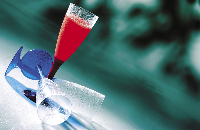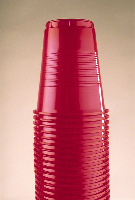Plastic Glassware
The plastic glassware of today can be stylish, modern and flexible. There is a range of materials available which allow for often creative and eye-catching designs to be produced. The glassware is safer than real glass and often much harder to break. They range from cheap, throw-away to expensive and glamorous.
Many plastic materials can be used, each with different poperties.
Acrylic Acrylic glasses are usually rigid and quite thin walled. They are well insulated, keeping the drink inside cool. The plastic does not significantly degrade or discolour over time if it is cared for. It is susceptible to scratching, however, these can be buffed out.
Polycarbonate (PC) Styrene Acrylonitrile (SAN) Polystyrene
Plastic is a durable and flexible material and there are many finishes that can be achieved. Here is a list of some of them:
Colours
Insulated Elite Stackable Decorated
When comparing plastic with glass, it is often up to the individual's viewpoint to decide whether each aspect is an advantage or disadvantage.
Look and feel
Breakability
Child Friendly Weight Flammability Recycling Whatever your opinion of plastic glassware, there is no doubt there are times when plastic is better and other times when glass is better. It all depends on personal taste and circumstance.
Materials
Acrylic glasses used to be considered cheap and brittle. Nowadays, things have improved and there is a range of quality available.

These are often billed as being unbreakable. This is not completely true - they are very sturdy but a determined effort will cause them to break. Polycarbonate often has a better quality feel to it, although this does depend on the design.
This material is particularly sought after by commercial establishments where high temperature dishwashers are used. SAN boasts the ability to withstand very high temperatures and can be used to serve hot drinks in. It is a very strong material with good chemical resistance.
Polystyrene cups tend to be quite flimsey and often found in vending machines. They cannot be made clear so are often white or beige. They have good insulating properties and thick walled cups are often used to serve hot, take-away drinks in.
Features
Plastic glassware can be made in just about every colour in the rainbow, including see-through and luminous.

A double wall of polycarbonate is used to produce insulated cups that will keep drinks cool or hot for longer.
There are elite ranges available in most materials which claim to be better quality. They are usually made from thicker walls or have some unique aspect of their design, such as an interesting shape.
Often plastic glassware can be stacked for ease of storage. Real glass cups can break if stored in stacks.
The plastic glasses can be decorated with patterns, pictures and can even be moulded to resemble cut glass.
Advantages and Disadvantages of Plastic Drinkware
Glass normally has a superior look and feel to plastic plus it makes an interesting sound, especially crystal glass with its clear, ringing 'ting'. Some plastic designs do have superior quality or a look and feel which is distinctive. Plastic glasses can often achieve shapes not available in glass.
Plastic glasses will not break as easily as glass ones making them safer and more suitable for outside events.

Can you imagine a world without plastic cups for children? They are easy for children to use (eg, double handles for babies), can be fitted with no-spill tops and don't break. Ideal for youngsters.
Plastic weighs less than glass. This reduces transport costs which is an advantage. However, they can easily fall or blow away when empty.
Some plastics are prone to burning if in contact with a naked flame. This is a clear disadvantage over glass.
Both glass and plastic can be recycles - the trick is having the collection facilities.


